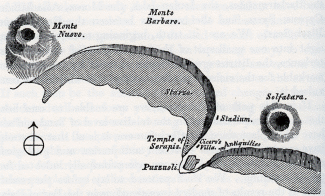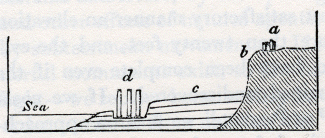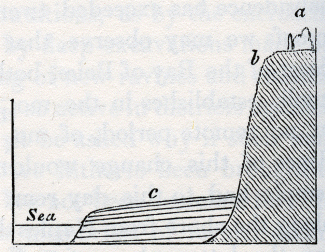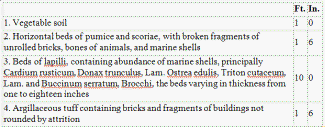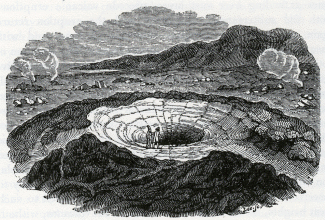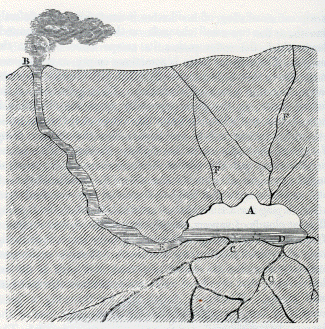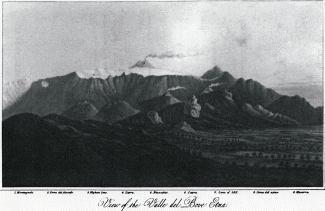Earthquake in Calabria, February 5th, 1783 – Shocks continued to the end of the year 1786 – Authorities – Extent of the area convulsed – Geological structure of the district – Difficulty of ascertaining changes of relative level even on the sea-coast – Subsidence of the quay at Messina – Shift or fault in the Round Tower of Terranuova – Movement in the stones of two obelisks – Alternate opening and closing of fissures – Cause of this phenomenon – Large edifices engulphed – Dimensions of new caverns and fissures – Gradual closing in of rents – Bounding of detached masses into the air – Landslips – Buildings transported entire, to great distances – Formation of fifty new lakes – Currents of mud – Small funnel-shaped hollows in alluvial plains – Fall of cliffs along the sea-coast – Shore near Scilla inundated – State of Stromboli and Etna during the shocks – Illustration afforded by this earthquake of the mode in which valleys are formed
OF the numerous earthquakes which have occurred in different parts of the globe, during the last hundred years, that of Calabria, in 1783, is the only one of which the geologist can be said to have such a circumstantial account as to enable him fully to appreciate the changes which this cause is capable of producing in the lapse of ages. The shocks began in February, 1783, and lasted for nearly four years, to the end of 1786. Neither in duration, nor in violence, nor in the extent of territory moved, was this convulsion remarkable, when contrasted with many experienced in other countries, both during the last and present century; nor were the alterations which it occasioned in the relative level of hill and valley, land and sea, so great as those effected by some subterranean movements in South America, in our own times. The importance of the earthquake in question arises from the circumstance, that Calabria is the only spot hitherto visited, both during and after the convulsions, by men possessing sufficient leisure, zeal, and scientific information, to enable them to collect and describe with accuracy the physical facts which throw light on geological questions.
Among the numerous authorities, Vivenzio, physician to the King of Naples, transmitted to the court a regular statement of his observations during the continuance of the shocks; and his narrative is drawn up with care and clearness. [1] Francesco Antonio Grimaldi, then secretary of war, visited the different provinces at the king's command, and published a most detailed description of the permanent changes in the surface. [2] He measured the length, breadth, and depth of the different fissures and gulphs which opened, and ascertained their number in many provinces. His comments, moreover, on the reports of the inhabitants, and his explanations of their relations, are judicious and instructive. Pignataro, a physician residing at Monteleone, a town placed in the very centre of the convulsions, kept a register of the shocks, distinguishing them into four classes, according to their degree of violence. From his work, it appears that, in the year 1783, the number was nine hundred and forty-nine, of which five hundred and one were shocks of the first degree of force; and in the following year there were one hundred and fifty-one, of which ninety-eight were of the first magnitude. Count Ippolito, also, and many others, wrote descriptions of the earthquake; and the Royal Academy of Naples, not satisfied with these and other observations, sent a deputation from their own body into Calabria, before the shocks had ceased, who were accompanied by artists instructed to illustrate by drawings the physical changes of the district, and the state of ruined towns and edifices. Unfortunately these artists were not very successful in their representations of the condition of the country, particularly when they attempted to express, on a large scale, the extraordinary revolutions which many of the great and minor river-courses underwent. But many of the plates published by the Academy are valuable; and we shall frequently avail ourselves of them to illustrate the facts about to be described. [3] In addition to these Neapolitan sources of information, our countryman, Sir William Hamilton, surveyed the district, not without some personal risk, before the shocks had ceased; and his sketch, published in the Philosophical Transactions, supplies many facts that would otherwise have been lost. He has explained in a rational manner many events which, as related in the language of some eye-witnesses, appeared marvellous and incredible. Dolomieu also examined Calabria, soon after the catastrophe, and wrote an account of the earthquake, correcting a mistake into which Hamilton had fallen, who supposed that a part of the tract shaken had consisted of volcanic tuff. It is, indeed, a circumstance which enhances the geological interest of the commotions which so often modify the surface of Calabria, that they are confined to a country where there are neither ancient nor modern rocks of igneous origin; so that at some future time, when the era of disturbance shall have passed by, the cause of former revolutions will be as latent as in parts of Great Britain now occupied exclusively by ancient marine formations.
The convulsion of the earth, sea, and air, extended over the whole of Calabria Ultra, the south-east part of Calabria Citra, and across the sea to Messina and its environs -- a district lying between the 38th and 39th degrees of latitude. The concussion was perceptible over a great part of Sicily, and as far north as Naples; but the surface over which the shocks acted so forcibly as to excite intense alarm, did not generally exceed five hundred square miles in circumference. The soil of that part of Calabria is composed chiefly, like the southern part of Sicily, of calcareo-argillaceous strata of great thickness, containing marine shells. This clay is sometimes associated with beds of sand and limestone. For the most part these formations resemble in appearance and consistency the Subapennine marls, with their accompanying sands and sandstones; and the whole group bears considerable resemblance, in the yielding nature of its materials, to most of our tertiary deposits in France and England. Chronologically considered, however, the Calabrian formations are comparatively of very modern date, and abound in fossil shells referrible to species now living in the Mediterranean.
We learn from Vivenzio, that on the 20th and 26th of March, 1783, earthquakes occurred in the islands of Zante, Cephalonia, and St. Maura; and in the last-mentioned isle several public edifices and private houses were overthrown, and many people destroyed. We have already shown that the Ionian Isles fall within the line of the same great volcanic region as Calabria; so that both earthquakes were probably derived from a common source, and it is not improbable that the bed of the whole intermediate sea was convulsed.
If the city of Oppido, in Calabria, be taken as a centre, and round that centre a circle be described with a radius of twenty-two miles, this space will comprehend the surface of the country which suffered the greatest alteration, and where all the towns and villages were destroyed. But if we describe the circle with a radius of seventy-two miles, this will then comprehend the whole country that had any permanent marks of having been affected by the earthquake. The first shock, of February 5th, 1783, threw down, in two minutes, the greater part of the houses in all the cities, towns, and villages, from the western flanks of the Apennines in Calabria Ultra, to Messina in Sicily, and convulsed the whole surface of the country. Another occurred on the 28th of March, with almost equal violence. The granitic chain which passes through Calabria from north to south, and attains the height of many thousand feet, was shaken but slightly; but it is said that a great part of the shocks which were propagated with a wave-like motion through the recent strata from west to east, became very violent when they reached the point of junction with the granite, as if a reaction was produced where the undulatory movement of the soft strata was suddenly arrested by the more solid rocks. The surface of the country often heaved like the billows of a swelling sea, which produced a swimming in the head like seasickness. It is particularly stated, in almost all the accounts, that just before each shock the clouds appeared motionless; and although no explanation is offered of this phenomenon, it is obviously the same as that observed in a ship at sea when it pitches violently. The clouds seem arrested in their career as often as the vessel rises in a direction contrary to their course; so that the Calabrians must have experienced precisely the same motion on the land.
We shall first consider that class of physical changes produced by the earthquake, which are connected with changes in the relative level of the different parts of the land; and afterwards describe those which are more immediately connected with the derangement of the regular drainage of the country, and where the force of running water co-operated with that of the earthquake.
In regard to alterations of relative level, none of the accounts establish that they were on a considerable scale; but it must always be remembered, that in proportion to the area moved is the difficulty of proving that the general level has undergone any change, unless the sea-coast happens to have participated in the principal movement. Even then it is often impossible to determine whether an elevation or depression even of several feet has occurred, because there is nothing novel in a band of sand and shingle of unequal breadth above the level of the sea, marking the point reached by the waves during springtides or the most violent tempests. The scientific investigator has not sufficient topographical knowledge to discover whether the extent of beach has diminished or increased; and he who has the necessary local information feels no interest in ascertaining the amount of the rise or fall of the ground. Add to this the great difficulty of making correct observations, in consequence of the enormous waves which roll in upon a coast during an earthquake, and efface every landmark near the shore.
It is evidently in sea-ports alone that we can look for very accurate indications of slight changes of level; and when we find them, we may presume that they would not be rare at other points, if equal facilities of comparing relative altitudes were afforded. Grimaldi states (and his account is confirmed by Hamilton and others) that at Messina in Sicily the shore was rent; and the soil along the port, which before the shock was perfectly level, was found afterwards to be inclined towards the sea, the sea itself near the "Banchina" becoming deeper, and its bottom in several places disordered. The quay also sank down about fourteen inches below the level of the sea, and the houses in its vicinity were much fissured. [4] Among various proofs of partial elevation and depression in the interior, the Academicians mention, in their Survey, that the ground was sometimes on the same level on both sides of new ravines and fissures, but sometimes there had been a considerable shifting, either by the upheaving of one side or the subsidence of the other. Thus, on the sides of long rents in the territory of Soriano, the stratified masses had altered their relative position to the extent of from eight to fourteen palms (six to ten and a half feet). Similar shifts in the strata are alluded to in the territory of Polistena, where there appeared innumerable fissures in the earth. One of these was of great length and depth; and in parts, the level of the corresponding sides was greatly changed. In the town of Terranuova, some houses were seen uplifted above the common level, and others adjoining sunk down into the earth. In several streets, the soil appeared thrust up, and abutted against the walls of houses; a large circular tower of solid masonry, which had withstood the general destruction, was divided by a vertical rent, and one side was upraised, and the foundations heaved out of the ground. It was compared by the Academicians to a great tooth half extracted from the alveolus, with the upper part of the fangs exposed. (See cut No. 20.)
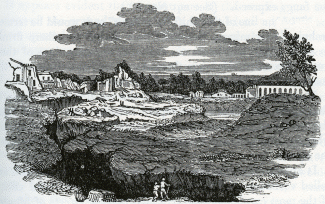
No. 19. Deep fissure near Polistena, caused by the earthquake of 1783.
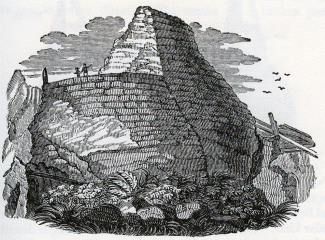
No. 20. Shift or "fault" in the round tower of Terranuova in Calabria, occasioned by the earthquake of 1783.
Along the line of this shift, or "fault" as it would be termed technically by miners, the walls were found to adhere firmly to each other, and to fit so well, that the only signs of their having been disunited was the want of correspondence in the courses of stone on either side of the rent.
In some walls which had been thrown down, or violently shaken, in Monteleone, the separate stones were parted from the mortar so as to leave an exact mould where they had rested, whereas in other cases the mortar was ground to dust between the stones.
It appears that the wave-like motions, and those which are called vorticose or whirling in a vortex, often produced effects of the most capricious kind. Thus, in some streets of Monteleone, every house was thrown down but one; in others, all but two; and the buildings which were spared were often scarcely in the least degree injured.
In many cities of Calabria, all the most solid buildings were thrown down, while those which were slightly built, escaped; but at Rosarno, as also at Messina, in Sicily, it was precisely the reverse, the massive edifices being the only ones that stood.
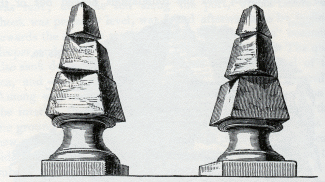
No. 21
Two obelisks (No. 21) placed at the extremities of a magnificent facade in the convent of S. Bruno, in a small town called Stefano del Bosco, were observed to have undergone a movement of a singular kind. The shock which agitated the building is described as having been horizontal and vorticose. The pedestal of each obelisk remained in its original place; but the separate stones above were turned partially round, and removed sometimes nine inches from their position, without falling.
It appears evident that a great part of the rending and fissuring of the ground was the effect of a violent motion from below upwards; and in a multitude of cases where the rents and chasms opened and closed alternately, we must suppose that the earth was by turns heaved up, and then let fall again. We may conceive the same effect to be produced on a small scale, if, by some mechanical force, a pavement composed of large flags of stone should be raised up and then allowed to fall suddenly, so as to resume its original position. If any small pebbles happened to be lying on the line of contact of two flags, they would fall into the opening when the pavement rose, and be swallowed up, so that no trace of them would appear after the subsidence of the stones. In the same manner, when the earth was upheaved, large houses, trees, cattle, and men were engulphed in an instant in chasms and fissures; and when the ground sank down again, the earth closed upon them, so that no vestige of them was discoverable on the surface. In many instances, individuals were swallowed up by one shock, and then thrown out again alive, together with large jets of water, by the shock which immediately succeeded.
At Jerocarne, a country which, according to the Academicians, was lacerated in a most extraordinary manner, the fissures ran in every direction like cracks on a broken pane of glass (see cut No. 22) and, as a great portion of them remained open after the shocks, it is very possible that this country was permanently upraised.
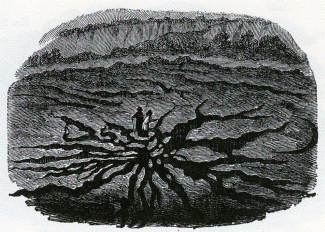
No. 22. Fissures near Jerocarne, in Calabria, caused by the earthquake of 1783.
In the vicinity of Oppido, the central point from which the earthquake diffused its violent movements, many houses were swallowed up by the yawning earth, which closed immediately over them. In the adjacent district also of Cannamaria, four farm-houses, several oil-stores, and some spacious dwelling-houses were so completely engulphed in one chasm, that not a vestige of them was afterwards discernible. The same phenomenon occurred at Terranuova, S. Christina, and Sinopoli. The Academicians state particularly that when deep abysses had opened in the argillaceous strata of Terranuova, and houses had sunk into them, the sides of the chasms closed with such violence, that, on excavating afterwards to recover articles of value, the workmen found, the contents and detached parts of the buildings jammed together so as to become one compact mass. It is unnecessary to accumulate examples of similar occurrences; but so many are well authenticated during this earthquake in Calabria, that we may, without hesitation, yield assent to the accounts of catastrophes of the same kind repeated again and again in history, where whole towns are declared to have been engulphed, and nothing but a pool of water or tract of sand left in their place.
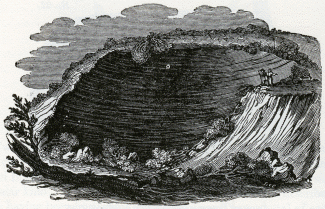
No. 23. Chasm formed by the earthquake of 1783, near Oppido, in Calabria.
On the sloping side of a hill near Oppido, a great chasm opened, and, although a large quantity of soil was precipitated into the abyss, together with a considerable number of olive-trees and part of a vineyard, a great gulph remained after the shock in the form of an amphitheatre, five hundred feet long and two hundred feet deep (see cut No. 23).
According to Grimaldi, many fissures and chasms, formed by the first shock of February 5th, were greatly widened, lengthened, and deepened by the violent convulsions of March 28th. In the territory of San Fili, this observer found a new ravine, half a mile in length, two feet and a half broad, and twenty-five feet deep; and another of similar dimensions in the territory of Rosarno. A ravine nearly a mile long, one hundred and five feet broad, and thirty feet deep, opened in the district of Plaisano, where, also, two gulphs were caused -- one in a place called Cerzulle, three quarters of a mile long, one hundred and fifty feet broad, and above one hundred feet deep, and another at La Fortuna, nearly a quarter of a mile long, above thirty feet in breadth, and no less than two hundred and twenty-five feet deep. In the district of Fosolano three gulphs opened: one of these measured three hundred feet square, and above thirty feet deep; another was nearly half a mile long, fifteen feet broad, and above thirty feet deep; the third was seven hundred and fifty feet square. Lastly, a calcareous mountain, called Zefirio, at the southern extremity of the Italian peninsula, was cleft in two for the length of nearly half a mile, and an irregular breadth of many feet. Some of these chasms were in the form of a crescent. The annexed cut (No. 24) represents one by no means remarkable for its dimensions, which remained open by the side of a small pass over the hill of St. Angelo, near Soriano. The small river Mesima is seen in the foreground.
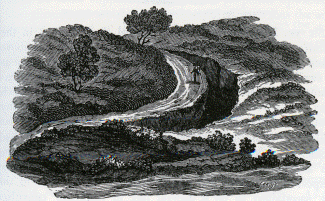
No. 24. Chasm in the hill of St. Angelo, near Soriano, in Calabria, caused by the earthquake of 1783.
In the vicinity of Seminara, a lake was suddenly formed by the opening of a great chasm, from the bottom of which water issued. This lake was called Lago del Tolfilo. It extended 2380 palms in length, by 1250 in breadth, and 70 in depth. The inhabitants, dreading the miasma of this stagnant pool, endeavoured, at great cost, to drain it by canals, but without success, as it was fed by springs issuing from the bottom of the deep chasm. A small circular subsidence occurred not far from Polistena, of which a representation is given in the annexed cut.
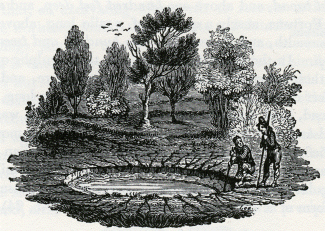
No. 25. Circular pond near Polistena, in Calabria, caused by the earthquake in 1783.
Sir W. Hamilton was shown several deep fissures in the vicinity of Mileto, which, although not one of them was above a foot in breadth, had opened so wide during the earthquake as to swallow up an ox and near one hundred goats. The Academicians also found, on their return through districts which they had passed at the commencement of their tour, that many rents had in that short interval gradually closed in, so that their width had diminished several feet, and the opposite walls had sometimes nearly met. It is natural that this should happen in argillaceous strata, while in more solid rocks we may expect that fissures will remain open for ages. Should this be ascertained to be a general fact in countries convulsed by earthquakes, it would afford a satisfactory explanation of a common phenomenon in mineral veins. Such veins often retain their full size so long as the rocks consist of limestone, granite, or other indurated materials; but they contract their dimensions, become mere threads, or are even entirely cut off, where masses of an argillaceous nature are interposed. If we suppose the filling up of fissures with metallic and other ingredients to be a process requiring ages for its completion, it is obvious that the opposite walls of rents, where strata consist of yielding materials, must collapse or approach very near to each other before sufficient time is allowed for the accretion of a large quantity of veinstone.
It is stated by Grimaldi that the thermal waters of St. Euphemia, in Terra di Amato, which first burst out during the earthquake of 1638, acquired, in February 1783, an augmentation both in quantity and degree of heat. This fact appears to indicate a connexion between the heat of the interior and the fissures caused by the Calabrian earthquakes, notwithstanding the absence of volcanic rocks either ancient or modern in that district.
The violence of the movement of the ground upwards was singularly illustrated by what the Academicians call the "sbalzo," or bounding into the air, to the height of several yards, of masses slightly adhering to the surface. In some towns a great part of the pavement-stones were thrown up, and found lying with their lower sides uppermost. In these cases we must suppose that they were propelled upwards by the momentum which they had acquired, and that the adhesion of one end of the mass being greater than that of the other, a rotatory motion had been communicated to them. When the stone was projected to a sufficient height to perform somewhat more than a quarter of a revolution in the air, it pitched down on its edge and fell with its lower side uppermost.
The next class of effects to be considered, are those more immediately connected with the formation of valleys, in which the action of water was often combined with that of the earthquake. The country agitated was composed, as we before stated, chiefly of argillaceous strata, intersected by deep narrow valleys, sometimes from five to six hundred feet deep. As the boundary cliffs were in great part vertical, it will readily be conceived that, amidst the various movements of the earth, the precipices overhanging the rivers, being without support on one side, were often thrown down. We find, indeed, that inundations produced by obstructions in river-courses are among the most disastrous consequences of great earthquakes in all parts of the world; for the alluvial plains in the bottoms of valleys are usually the most fertile and well peopled parts of the whole country, and whether the site of a town is above or below a temporary barrier in the channel of a river, it is exposed to injury by the waters either of a lake or a flood.
From each side of the deep valley or ravine of Terranuova, enormous masses of the adjoining flat country were detached and cast down into the course of the river, so as to give rise to great lakes. Oaks, olive-trees, vineyards, and corn, were often seen growing at the bottom of the ravine, as little injured as their companions from which they were separated in the plain above at least five hundred feet higher, and at the distance of about three-quarters of a mile. In one part of this ravine was an enormous mass, two hundred feet high, and about four hundred feet in diameter at its basis, which had been detached by some former earthquake. It is well attested that this mass travelled down the ravine near four miles, having been put in motion by the earthquake of the 5th of February. Hamilton, after examining the locality, declared that this phenomenon might be accounted for by the declivity of the valley, the great abundance of rain which fell, and the great weight of the alluvial matter which pressed behind it. The momentum of the "terre movitine," or lavas, as the flowing mud is called in the country, is no doubt very great; but the transportation of masses that might be compared to small hills, for a distance of several miles at a time, is an effect which could never have been anticipated: and the fact should serve as a hint to those geologists who are fond of appealing to alluvial phenomena as proofs of the superior violence of aqueous causes in former ages.
The first account sent to Naples of the two great slides or landslips above alluded to, which caused a great lake near Terranuova, was couched in these words: -- "Two mountains on the opposite sides of a valley walked from their original position until they met in the middle of the plain, and there joining together, they intercepted the course of a river, &c." The expressions here used resemble singularly those applied to phenomena, probably very analogous, which are said to have occurred at Fez, during the great Lisbon earthquake, as also in Jamaica and Java at other periods.
Not far from Soriano, which was levelled to the ground by the great shock of February the 5th, a small valley, containing a beautiful olive-grove, called Fra Ramondo, underwent a most extraordinary revolution. Innumerable fissures first traversed the river-plain in all directions, and absorbed the water until the argillaceous substratum became soaked, and a great part of it was reduced to a state of fluid paste. Strange alterations in the outline of the ground were the consequence, as the soil to a great depth was easily moulded into any form. In addition to this change, the ruins of the neighbouring hills were precipitated into the hollow; and while many olives were uprooted, others remained growing on the fallen masses, and inclined at various angles (see cut No. 26). The small river Caridi was entirely concealed for many days; and when at length it reappeared, it had shaped for itself an entirely new channel.
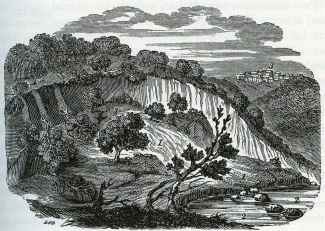
No. 26. Changes of the surface of Fra Ramondo, near Soriano, in Calabria. 1. Portion of a hill covered with olives thrown down. 2. New bed of the river Caridi. 3. Town of Soriano.
Near Seminara, an extensive olive-ground and orchard were hurled to a distance of two hundred feet, into a valley sixty feet in depth. At the same time a deep chasm was riven in another part of the high plateau from which the orchard had been detached, and the river immediately entered the fissure, leaving its former bed completely dry. A small inhabited house, standing on the mass of earth carried down into the valley, went along with it entire, and without injury to the inhabitants. The olive-trees, also, continued to grow on the land which had slid into the valley, and bore the same year an abundant crop of fruit.
Two tracts of land on which a great part of the town of Polistena stood, consisting of some hundreds of houses, were detached into a contiguous ravine, and nearly across it about half a mile from their original site; and, what is most extraordinary, several of the inhabitants were dug out from the ruins alive, and unhurt.
Two tenements, near Mileto, called the Macini and Vaticano, about a mile long, and half a mile broad, were carried for a mile down a valley. A thatched cottage, together with large olive and mulberry-trees, most of which remained erect, were carried uninjured to this extraordinary distance. According to Hamilton, the surface removed had been long undermined by rivulets, which were afterwards in full view on the bare spot deserted by the tenements. The earthquake seems to have opened a passage in the adjoining argillaceous hills, by which water charged with loose soil had suddenly taken its course into the subterranean channels of the rivulets immediately under the tenements, so that the entire piece of ground was floated off. Another example of subsidence, where the edifices were not destroyed, is mentioned by Grimaldi, as having taken place in the city of Catanzaro, the capital of the province of that name. The houses in the quarter called San Giuseppe subsided with the ground to various depths from two to four feet, but the buildings remained uninjured.
It would be tedious, and our space would not permit us, to follow the different authors through their local details of landslips produced in numerous minor valleys; but they are highly interesting, as showing to how great an extent the power of rivers to widen valleys, and to carry away large portions of soil towards the sea, is increased where earthquakes are of periodical occurrence. Among other territories, that of Cinquefrondi was greatly convulsed, various portions of soil being raised or sunk, and innumerable fissures traversing the country in all directions (see cut No. 27). Along the flanks of a small valley in this district there appears to have been an almost uninterrupted line of landslips.
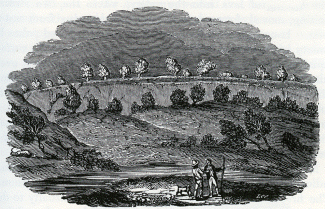
No. 27. Landslips near Cinquefrondi, caused by the earthquakes of 1783.
Vivenzio states, that near Sitizzano a valley was very nearly filled up to a level with the high grounds on each side, by the enormous masses detached from the boundary hills, and cast down into the course of two streams. By this barrier a lake was formed of great depth, about two miles long and a mile broad. The same author mentions that upon the whole, there were fifty lakes occasioned during the convulsions, and he assigns localities to all of these. The government surveyors enumerated two hundred and fifteen lakes, but they included in this number many small and insignificant ponds.
Near S. Lucido, among other places, the soil is described as having been "dissolved," so that large torrents of mud inundated all the low grounds, like lava. Just emerging from this mud, the tops only of trees and of the ruins of farm-houses, were seen. Two miles from Laureana the swampy soil in two ravines became filled with calcareous matter, which oozed out from the ground immediately before the first great shock. This mud, rapidly accumulating, began, ere long, to roll onward like a flood of lava into the valley, where the two streams uniting, moved forward with increased impetus from east to west. It now presented a breadth of three hundred palms by twenty in depth, and before it ceased to move, covered a surface equal in length to an Italian mile. In its progress it overwhelmed a flock of thirty goats, and tore up by the roots many olive and mulberry-trees, which floated like ships upon its surface. When this calcareous lava had ceased to move, it gradually became dry and hard, during which process the mass was lowered ten palms. It contained fragments of earth of a ferruginous colour, and emitting a sulphureous smell.
Many of the appearances exhibited in the alluvial plains indicate clearly the alternate rising and sinking of the ground. The first effect of the more violent shocks was usually to dry up the rivers, but they immediately afterwards overflowed their banks. Along the alluvial plains, and in marshy places, an immense number of cones of sand were thrown up. These appearances Hamilton explains, by supposing that the first movement raised the fissured plain from below upwards, so that the rivers and stagnant waters in bogs sank down, or at least were not upraised with the soil. But when the ground returned with violence to its former position, the water was thrown up in jets through fissures. [5]
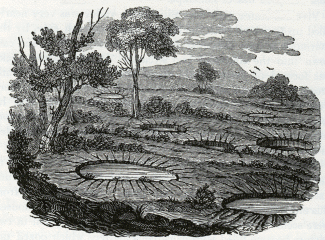
No. 28. Circular hollows in the plain of Rosarno, formed by the earthquake of 1783.
In the Report of the Academy, we find that some plains were covered with circular hollows, for the most part about the size of carriage-wheels, but often somewhat larger or smaller. When filled with water to within a foot or two of the surface, they appeared like wells; but, in general, they were filled with dry sand, sometimes with a concave surface, and at other times convex. On digging down, they found them to be funnel-shaped, and the moist loose sand in the centre marked the tube up which the water spouted. The annexed cut represents a section of one of these inverted cones when the water had disappeared, and nothing but dry micaceous sand remained.
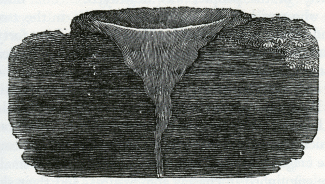
No. 29.
Along the sea-coast of the straits of Messina, near the celebrated rock of Scilla, the fall of huge masses detached from the bold and lofty cliffs overwhelmed many villas and gardens. At Gian Greco a continuous line of cliff, for a mile in length, was thrown down. Great agitation was frequently observed in the bed of the sea during the shocks, and, on those parts of the coast where the movement was most violent, all kinds of fish were taken in greater abundance, and with much greater facility. Some rare species, as that called Cicirelli, which usually lie buried in the sand, were taken on the surface of the waters in great quantity. The sea is said to have boiled up near Messina, and to have been agitated as if by a copious discharge of vapours from its bottom. The Prince of Scilla had persuaded a great part of his vassals to betake themselves to their fishing-boats for safety, and he himself had gone on board. On the night of the 5th of February, when some of the people were sleeping in the boats, and others on a level plain slightly elevated above the sea, the earth rocked, and suddenly a great mass was torn from the contiguous Mount Jaci, and thrown down with a dreadful crash upon the plain. Immediately afterwards, the sea rising thirty palms above the level of this low tract, rolled foaming over it, and swept away the multitude. It then retreated, but soon rushed back again with greater violence, bringing with it some of the people and animals it had carried away. At the same time every boat was sunk or dashed against the beach, and some of them were swept far inland. The aged Prince, with one thousand four hundred and thirty of his people, was destroyed. The number of persons who perished during the earthquake in the two Calabrias and Sicily is estimated by Hamilton at about forty thousand, and about twenty thousand more died by epidemics which were caused by insufficient nourishment, exposure to the atmosphere, and malaria, arising from the new stagnant lakes and pools. By far the greater number were buried under the ruins of their houses; while some were burnt to death in the conflagrations which almost invariably followed the shocks, and consumed immense magazines of oil and other provisions, A small number were engulphed in chasms and fissures, and their skeletons are perhaps buried in the earth to this day, at the depth of several hundred feet, for such was the profundity of some of the openings which did not close in again.
The inhabitants of Pizzo remarked, that on the 5th of February, 1783, when the first great shock afflicted Calabria, the volcano of Stromboli, which is in full view of that town, and at the distance of about fifty miles, smoked less, and threw up a less quantity of inflamed matter, than it had done for some years previously. On the other hand, the great crater of Etna is said to have given out a considerable quantity of vapour towards the beginning, and Stromboli towards the close of the commotions. But as no eruption happened from either of these great vents during the whole earthquake, the sources of the Calabrian convulsions, and of the volcanic fires of Etna and Stromboli, appear to be very independent of each other; unless, indeed, they have the same mutual relation as Vesuvius and the volcanos of the Phlegraean Fields and Ischia, a violent disturbance in one district serving as a safety-valve to the other, and both never being in full activity at once.
It is impossible for the geologist to consider attentively the effect of this single earthquake of 1783, and to look forward to the alterations in the physical condition of the country to which a continued series of such movements will hereafter give rise, without perceiving that the formation of valleys by running water can never be understood, if we consider the question independently of the agency of earthquakes. Rivers do not begin to act, as some seem to imagine, when a country is already elevated far above the level of the sea, but while it is rising or sinking by successive movements. Whether Calabria is now undergoing any considerable change of relative level, in regard to the sea, or is, upon the whole, nearly stationary, is a question which our observations, confined almost entirely to the last half century, cannot possibly enable us to determine. But we know that strata, containing species of shells identical with those now living in the contiguous parts of the Mediterranean, have been raised in this country, as they have in Sicily, to the height of several thousand feet. Now those geologists who merely grant that the present course of Nature, in the inanimate world, has been unchanged since the existing species of animals were in being, will not feel surprise that the Calabrian streams and rivers have cut out of such comparatively modern strata a great system of valleys varying in depth from fifty to six hundred feet, and often several miles wide, when they consider how numerous must have been the earthquakes which lifted those recent marine strata to so prodigious a height. Some speculators, indeed, who disregard the analogy of existing Nature, and who are as prodigal of violence as they are thrifty of time, may suppose that Calabria "rose like an exhalation" from the deep, after the manner of Milton's Pandemonium. But such an hypothesis will deprive them of that peculiar removing force required to form a regular system of deep and wide valleys, for time is essential to the operation. Landslips must be cleared away in the intervals between subterranean movements, otherwise fallen masses will serve as buttresses to the precipitous cliffs bordering a valley, so that the succeeding earthquake will be unable to exert its full power. Barriers must be worn through and swept away, and steep or overhanging cliffs again left without support, before another shock can take effect in the same manner.
If a single convulsion be too violent, and agitate at once an entire hydrographical basin, or if the shocks follow each other too rapidly, the previously-existing valleys will be annihilated, instead of being modified and enlarged. Every stream will be compelled to begin its operations anew, and to open for itself a passage through strata before undisturbed, instead of continuing to deepen and widen channels already in great part excavated. On the other hand, if, consistently with all that is known from observation of the laws which regulate subterranean movements, we consider their action to have been intermittent -- if sufficient periods have always intervened between the severer shocks to allow the drainage of the country to be nearly restored to its original state, then are both the kind and degree of force supplied which may enable running water to hollow out a valley of any depth and size consistent with the degree of elevation above the sea which the district in question may happen at any time to have attained during a succession of physical revolutions.
Notwithstanding the great derangement caused by violent earthquakes, there is an evident tendency in running water to remain constant to the same connected series of valleys. The softening of the soil is invariably greatest in the channels of rivers and in alluvial plains. The water is absorbed in an infinite number of rents, and when the ground is swelled with water it is reduced almost to a state of mud by the vehement agitation of the ground in every direction, and often for several years consecutively. The erosive and transporting action of running water is, therefore, facilitated in the tracts already excavated.
When we read of the drying up and desertion of the channels of rivers, the accounts most frequently refer to their deflection into some other part of the same alluvial plain, perhaps several miles distant. Under certain circumstances a change of level may undoubtedly force the water to flow over into some distinct hydrographical basin; but even then it will fall immediately into valleys already formed. Provided, therefore, we suppose the elevation and subsidence of mountain-chains to be a gradual process, there is no difficulty in explaining how the rivers draining our continents have converted ravines into valleys, and enlarged and deepened valleys to an enormous extent. On the contrary, the signs of slow and gradual action so manifest in the sinuosities and other characters of valleys are admirably reconcileable with the great width and depth of the excavations, if we are content not only to suppose a great succession of ordinary earthquakes, but also the usual intervals of time between the shocks.
We may observe that earthquakes alone could never give rise to a regular system of valleys ramifying from a main trunk like the veins from the great arteries of the human body. On the contrary, they would, in the course of time, destroy every system of valleys on the globe, were it not for the agency of aqueous causes. We learn from history that ever since the first Greek colonists, the Bruttii, settled in Calabria, that region has been subject to devastation by earthquakes, and, for the last century and a half, ten years have seldom elapsed without a shock; but the severer convulsions have not only been separated by intervals of twenty, fifty, or one hundred years, but have not affected precisely the same points when they recurred. Thus the earthquake of 1783, although confined within the same geographical limits as that of 1638, and not very inferior in violence, visited, according to Grimaldi, very different localities. The points where the local intensity of the force is developed, being thus perpetually varied, more time is allowed for the removal of separate mountain masses thrown into river channels by each shock.
When chasms and deep hollows open at the bottom of valleys, they must often be filled with those "mud lavas" before described; and these must be extremely analogous to the enormous ancient deposits of mud which are seen in many countries, as in the basin of the Tay, Isla, and North Esk rivers, for example, in Scotland -- alluvions hundreds of feet thick, which are neither stratified nor laminated like the sediment which subsides from water. Whenever a landslip blocks up a river, these currents of mud will be arrested, and accumulate to an enormous depth.
The transportation for several miles at a time, of masses as large as great edifices by the momentum of these floods of mud combined with the motion of the earthquake, and the enveloping of land animals, together with many other facts mentioned in the Calabrian account, cannot but excite in the mind of every geologist a strong desire to become more acquainted with the changes now in progress in those vast regions of the globe which are habitually devastated by earthquakes. To our extreme ignorance of this important class of phenomena we may probably refer the obscurity of many of the appearances of superficial alluvions throughout the greater part of Europe, as well as the diversity of opinion relating to them, and the extravagant theories which have passed current.
The portion of the Calabrian valleys formed within the last three thousand years, must, undoubtedly, be inconsiderable in amount, compared to that previously formed, just as the lavas which have flowed from Etna since the historical era constitute but a small proportion of the whole cone. But as a continued series of such eruptions as man has witnessed would reproduce another cone like Etna, so a sufficient number of earthquakes like that of 1783 would enable torrents and rivers to re-excavate all the Calabrian valleys if they were now to be entirely obliterated. It must be evident that more change is effected in two centuries in the width and depth of the valleys of that region, than in many thousand years in a country as undisturbed by earthquakes as Great Britain. For the same reason, therefore, that he who desires to comprehend the volcanic phenomena of Central France will repair to Vesuvius, Etna, or Hecla, so they who aspire to explain the mode in which valleys are formed must visit countries where earthquakes are of frequent occurrence. For we may be assured, that the power which uplifted our more ancient tertiary strata of marine origin to more than a thousand feet above the level of the sea, co-operated at some former epoch with the force of rivers in the removal of large portions of rock and soil, just as the elevatory power which has upraised newer strata to the height of several thousand feet in the south of Italy has caused those formations to be already intersected by deep valleys and ravines.
He who studies the hydrographical basin of the Thames, and compares its present state with its condition when it was a Roman province, may have good reason to declare that if that river and its tributaries had since their origin been always as inactive, and as impotent as they are now, they could never, not even in millions of years, have excavated the valleys through which they flow: but, if he concludes from these premises, that the valleys in this basin were not formed by ordinary causes, he reasons like one, who having found a solfatara which for many centuries has thrown out nothing more than vapour and a few handfuls of sand and scoriae, infers that a lofty cone, composed of successive streams of lava and ejections, can no longer be produced by volcanic agency.
_______________
Notes:
1. Istoria de' Tremuoti della Calabria, del 1783.
2. Descriz. de' Tremuoti Accad. nelle Calabria nel 1783. Napoli, 1784.
3. Istoria de' Fenomeni del Tremoto, &c. nell' an. 1783, posta in luce dalla Real. Accad., &c., di Nap. Napoli, 1784, fol.
4. Phil. Trans., 1783.
5. Phil. Trans., vol. lxxiii., p. 180.

